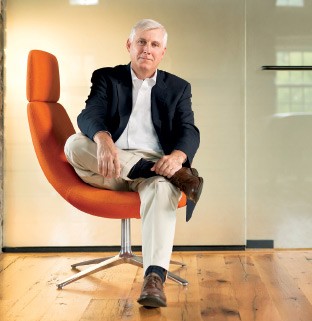Experian’s Big Data Transformation
Experian dodged a bullet in the 2008 financial crisis. It also learned a lesson: Act as if the next downturn is just around the corner.
With most of the financial industry flat on its back during the Great Recession, the consumer credit reporting company relied on its business model and geographic diversity to protect it from the worst of the carnage. Clients still needed credit reporting, but their interests had changed from finding the most promising borrowers to pinpointing those least likely to default.
Experian had also just undergone a restructuring, helping to cut costs just before the downturn hit. In addition, the company’s global diversity, particularly in Latin America, helped insulate it from the financial turmoil in the U.S. and Europe. Experian’s revenues flattened but did not fall in the years following the subprime mortgage crisis, and growth resumed in 2011.
But the lessons of the financial crisis were not lost on the company’s leadership, which initiated a global strategic investment program consisting of more than 20 new projects meant to diversify the business and hedge against another downturn.
“The strategy got us into areas that are relatively inelastic,” says Barry Libenson, a veteran CIO who joined the company in 2015. “We saw what happened during the recession and were committed to not letting that happen again Share on X.”
Tricky Transformation
Today’s Experian looks little like the company it was a decade ago. Still a juggernaut in the credit reporting industry, the company now defines itself as a global technology company.
Experian has expanded its footprint. It now helps automotive dealers better understand their customers and track their wheeled assets. It aids hospitals in minimizing bad debt by designing customized payment plans for patients. Last year it rolled out Experian Boost, a service that enables consumers to improve their credit scores by allowing them to add information to their Experian credit files—opening up a new way for Americans to show themselves as a good risk to lenders. It all adds up to more than 800 products, and one thing ties them together.
“If people participate in the discussion they will align, even if they disagree.”
—Barry Libenson, global CIO, Experian
“Data,” says Mr. Libenson, “is everything.”
Experian’s choice of Mr. Libenson to lead the overhaul of its technology infrastructure as global CIO was a break from the norm in the typically insular financial services industry. He had previously worked in diverse industries like industrial machinery, agriculture and retail grocery—but not a day in financial services. That was just fine with Experian, Mr. Libenson says.
“This company was looking for a very different background under the premise that if you keep doing the same thing, you’re going to get the same result,” he recalls. It turned out Mr. Libenson’s multifaceted background was a good fit for a business that was itching to branch out.
“I learned about lean manufacturing from 10 years in that industry and about large-scale transactional volumes for a retailer with 75,000 checkout lines operating simultaneously,” Mr. Libenson says. “At Experian, both of those things are now important.”
As CIO, his charter was to build the technology foundation for Experian’s digital transformation. Such transformations often start by centralizing data. After that, a CIO implements new processes that minimize overhead and speed time to market, like cloud and mobile computing. These changes become invisible to the customer, enabling the organization to constantly innovate. That gives a company like Experian a head start to building a sustainable competitive advantage.
But for all the optimism, digital transformation initiatives are inherently very risky. Most, in fact, fail, and the culprit is usually people rather than technology. Like many companies that have made multiple acquisitions, Experian faced the challenge of harmonizing a portfolio of more than 15 acquired businesses, each with its own processing platforms, databases and development tools. Mr. Libenson has spent much of the last four years stitching those parts together and rebuilding Experian’s technical architecture.
The biggest challenge was engineering the transition from a decentralized organizational model to a centralized one. While decentralized structures built around a small-team approach can work well for small or highly diversified companies, Mr. Libenson explains that at a certain size, centralization can outweigh the benefits of agility by offering economies of scale. This only happens when a company nears $5 billion in revenue, he says. Experian’s revenues were nearly $4.9 billion in its most recent fiscal year.
Pulling everything together is a herculean task. The technology and data fabric that Mr. Libenson is putting in place spans 1,500 software developers over 39 countries, now tasked with becoming as a single coherent unit. The technology infrastructure strategy is based on open standards, portability and simplicity. The goal is to make it possible for software developed in one part of the world to run everywhere else, and to enable developers to build upon each other’s work through the use of a single set of software tools.
“The old waterfall cycle of a year between software releases doesn’t work anymore,” Mr. Libenson says. “We had to change the way we work.”
“If cost is the most important factor in your decisions, then you’ve missed the goal. We want to be known as the first-to-market with all these new technologies and analytic products.”
—Barry Libenson
First-to-Market—and Recession-Proof?
To put data at the center of the business, Experian had to change its culture first. And that took time. But Experian’s culture is well tuned to embrace change. “If people participate in the discussion, they will align even if they disagree,” Mr. Libenson says.
Diplomatic skills came to the fore early on when he arrived to find that the company was using three different commercial versions of a big data platform that would be critical to its transformation.
“We got all the most senior development, architecture and operations people in a room and showed them how much we could save by standardizing on one platform,” he said. “We got 90% agreement,” and no one has challenged the decision to standardize since.
Being global CIO of Experian demands about 250,000 air miles a year, mostly to Asia, South America and the U.K. (Experian’s corporate headquarters is in Dublin, and its operational headquarters are in Nottingham, England; Costa Mesa, California, USA; and São Paulo.)
The schedule can be exhausting, but the chance to experience cultural differences and understand the impact of regional regulations on a data-focused business has been exhilarating. Besides, “I’ve run global organizations most of my career,” he says. “Most people like me sort of thrive on this.”
The most important and technically challenging aspect of the transformation has been pulling data from across the company into a single database that can handle both massive scale and an unpredictable variety of information. Experian will use these next-generation big data platforms to expand into a wide range of new services.
For example, last year the company released Experian Ascend, a platform of 250 million redacted consumer records. With it, customers can calculate how much it would cost to send an offer to every consumer with a credit score of over 700 living in Southeast Ohio, for example, moving the map area and changing the figures with a just few clicks.
“This wasn’t even possible until a couple of years ago,” Mr. Libenson says. “We’ve been able to introduce products we couldn’t have dreamed of a short time ago.”
The shift to standardized platforms will ultimately save Experian money, but that is not what matters most, Mr. Libenson says. “If cost is the most important factor in your decisions, then you’ve missed the goal,” he says. “We want to be known as the first-to-market with all these new technologies and analytic products.”
In a business world obsessed with efficiency and customer experience, the companies that own the largest and most relevant troves of data are nearly recession-proof, Mr. Libenson believes.
That is why new products like Experian Boost are so important. Its stated purpose may be to help consumers bulk up their credit scores, but the data Experian gathers has a multitude of other uses, such as establishing credit profiles for people with no credit history, helping marketers better target promotions or enabling insurance companies to offer driver discounts based on alternative data sources. These correlations are often invisible without massive amounts of data and the new breed of tools that can analyze and learn from it.
“This is data that was historically not used or available,” he says. And the future potential is almost limitless. “What’s big today will be small tomorrow.”
“During a recession companies are less likely to spend money on technology. They go into conservation mode. Good companies understand that technology is a growth enabler and if you don’t pay attention to it your competitors will.”
—Barry Libenson
Proactively Preparing
Experian’s data initiatives are paying off. In its most recent fiscal year, the company reported organic revenue growth of 10%, with data services getting much of the credit. How well prepared is the company for the next downturn?
“We’re in pretty good shape,” Mr. Libenson says. “We have geographic and product diversification, and we think innovation is our competitive advantage. This isn’t a one-trick-pony kind of thing.” Others agree; Experian has made the Forbes list of the world’s 100 most innovative companies five years running.
No one knows the timing, size or length of the next recession, but there is no question it will one day arrive. The downturn of a decade ago taught Mr. Libenson about the importance of not burying your head in the sand.
“Of all the companies I’ve worked for, Experian is the most proactive about preparation,” he says. “Other companies have a tendency not to want to think about it.”
Experian’s global scope and diverse business model make risk management an essential core competency, one that has the organization constantly formulating what-if scenarios for a wide variety of external forces. “We deal with a lot of tricky issues around the world,” Mr. Libenson says, ticking off variables such as Brexit, cybersecurity threats, regulations and geopolitical issues. “A recession is just one of them.”
One lesson the company’s executives learned a decade ago was the value of going against conventional wisdom. The strategic investments it initiated in the pit of the recession accelerated its later growth and expansion.
“During a recession, companies are less likely to spend money on technology. They go into conservation mode,” Mr. Libenson says. That isn’t likely to be the case for his current employer. “Good companies understand that technology is a growth enabler—if you don’t pay attention to it, your competitors will.”
This article appeared in the Fall 2019 issue of Insigniam Quarterly, with the headline “Ready for the Next Recession.” To begin receiving IQ, go here.





